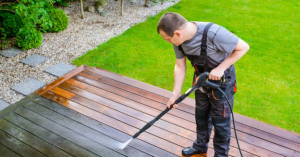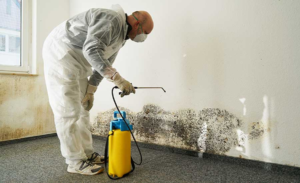Sarasota Pressure Washing removes most surfaces’ dirt, mildew, mold, and other debris. Unlike traditional cleaning methods, it’s less harsh on surfaces.
To prevent corrosion-induced damage, the nozzle’s force should be kept at least 10 inches away from electrical components, such as doorbells, security cameras, or backup generator cabinets.

A pressure washer can be a dangerous tool when used improperly. The highly pressurized water can damage wood surfaces such as decking or stucco and injure people if pointed at them. For this reason, it is imperative that you read and follow the instructions and safety manual that comes with your pressure washer.
When using a pressure washer, always stand back at least 12 inches from the surface you are cleaning. You should also avoid holding the spray tip close to your body or touching it with bare skin. The stream of water is powerful enough to penetrate your skin, and this could lead to serious injury.
Always wear eye protection, closed-toe shoes and work gloves while operating a pressure washer. The blast of water can lacerate your feet, and loose debris can hit you in the face or eyes. You should also wear ear protection if you have a gas-powered pressure washer because they can be quite noisy.
Ensure that the power cord, hose and connection to the pressure washer are free from cracks, cuts or kinks. It is also a good idea to use a filter in the water inlet to stop dirt and grit from entering your machine. If you’re planning on applying a detergent to the surface you are cleaning, make sure it is designed for this purpose and is being applied according to the manufacturer’s instructions.
Before starting a job, it’s important to scan your surroundings and remove anything that could be damaged by the high-pressure water spray, such as plants, cars or patio furniture. You should also keep children and pets away from the area you’re working in, as they can get sprayed by the water or be injured by the debris that gets kicked up by the nozzle.
When you’re ready to start, carefully inspect the pressure washer wand, nozzles and attachments for any signs of damage or wear. If you notice any issues, you should take the time to make the necessary repairs or replacements before you begin cleaning. Finally, before each use, make sure to fully unwind the hose and thoroughly inspect it for any kinks that may impede water flow.
Environmentally Friendly
Pressure washing is a great way to remove loose paint, grime and mold from surfaces such as walls, roofs, walkways, patios, driveways and paving. It is also a quick and effective method for removing oil, grease, and other chemical contaminants from equipment and surfaces. Regular cleanings can help protect the surface and extend its lifespan, saving money in repairs and replacements.
However, some power washing equipment is not eco-friendly and can harm the environment when used improperly. For example, inexperienced and unscrupulous power washers may use high pressure to apply chemicals that could be harmful to the environment or a person. These chemical compounds can then wash off the surface and flow into natural water bodies, contaminating the environment and posing a threat to wildlife and plants. Fortunately, there are eco-friendly cleaning methods that minimize environmental impact, such as soft washing and eco-friendly pressure washing.
These methods employ lower water pressures and use biodegradable detergents, reducing the risk of damage to the environment and ensuring that all components of the cleaning process are safe for animals, plants and humans. Eco-friendly pressure washing also utilizes low-emission engines and energy efficient pumps, minimizing air pollution and fuel usage.
The most obvious advantage of environmentally friendly pressure washing is its ability to conserve water, especially in regions facing a shortage of this resource. This water is then able to flow into other areas of the community where it is needed more, helping to alleviate drought conditions. Another benefit is that regular cleanings can extend the life of a building’s exterior and other surfaces, reducing the need for costly future repairs.
Dirt, grime and mold build-up not only look unattractive but can wear away at the material of a building’s external surfaces, causing structural damage. Regular cleanings can also help reduce health risks by reducing the presence of bacteria and vermin.
Depending on the region, it is also possible that pressure washing can come under the scrutiny of environmental regulations and stipulations on water usage and disposal. As such, it is important for homeowners and contractors to familiarize themselves with these regulations to ensure that they are following best practices for minimizing their environmental impact.
Saves Time
It takes a long time to scrub away grime with a sponge mop and a bucket of water. Pressure washing allows you to clean much larger areas in a fraction of the time. It also eliminates the need for harsh chemical cleaners that are bad for the environment and harmful to pets and wild animals that may come into contact with run-off.
A high-quality pressure washer is an investment that saves you a lot of time and effort. It also helps to protect your property from damage. Regularly cleaning your home and commercial buildings with a pressure washer prevents buildup of contaminants like mildew, mold, and debris. This keeps your surfaces looking like new for longer and reduces the risk of potential hazards that can arise from slippery substances.
Professional pressure washers are experienced in treating a variety of materials and can optimize the cleaning process to get the best results. They know appropriate water pressure levels, nozzle distances, and angles to use for different surface types. Inexperienced DIYers can accidentally blast surfaces like wood or brick with too much pressure, causing permanent damage.
Boosts Your Curb Appeal
A dirty home or commercial building gives the impression that you don’t care about your property and aren’t invested in your property’s appearance or maintenance. Regularly cleaning your property with a pressure washer will help to reaffirm that you take pride in your property and care about it’s appearance. This will increase your curb appeal and make a great first impression on any guests or customers that visit.
Improves the Value of Your Property
Dirty siding, a stained driveway, or an overgrown backyard can give the impression that your property is in poor condition and not worth much money. By regularly using a pressure washer to remove dirt, grime, and contaminants from your property, you can keep it in good shape and increase its value when it’s time to sell. This is especially important if you’re planning on selling your property in the near future.
Reduces Risk
Pressure washing is not just about restoring surfaces to their original appearance; it’s also about preventing damage that can lead to expensive repairs and replacements. When dirt, moss, mildew and other contaminants build up on structures like buildings, roofs, walkways and patios, they can cause structural damage, lead to rot and weaken the foundation. Over time, they can even weaken the materials in and around windows, doors and other building components. Regular cleanings, especially with a high-pressure washer, prevent these issues by removing the problem before it gets out of hand.
In addition, cleaning and sanitizing the surfaces of a building helps to improve indoor air quality. Mold, mildew, rust, and other unsightly stains leave behind odors that can make the interior of a building unpleasant to work or live in. Pressure washing helps to remove these odors, making a building healthier and more pleasant for people to spend time in.
Another way that a pressure wash can improve indoor air quality is by reducing allergens. Dust, dirt and pet dander can cause respiratory problems for people with allergies, and cleaning these particles from surfaces can help alleviate those symptoms. Pressurized washing also removes pollen from surfaces, which can be beneficial for anyone who suffers from seasonal allergies.
Many surfaces benefit from a periodic pressure wash, including asphalt, concrete, wood and vinyl siding. However, it is important to choose the correct pressure setting and use the proper technique for each surface type to avoid damage. It is also essential to select the right cleaning solution for each surface. For example, a wood cleaner should be used for wooden surfaces, while a vinyl cleaner is ideal for vinyl siding. It is also important to keep the nozzle at a safe distance from the surface and to move consistently to prevent focusing on one area for too long.
Adding pressure washing to your routine maintenance schedule is an inexpensive and effective way to help protect the value of your property, both residential and commercial. A well-maintained building is always more appealing to potential buyers, and it can be a great selling point.
